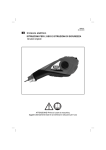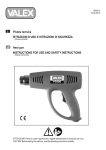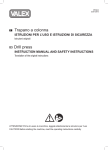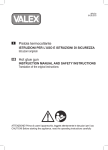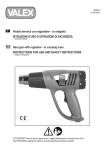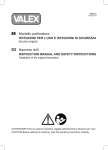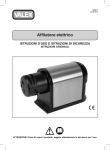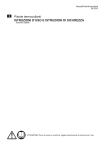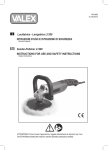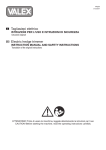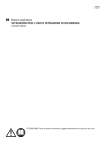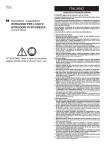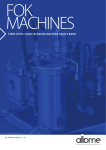Download Miscelatore Mixer
Transcript
MMiscel 28.02.2014 Miscelatore ISTRUZIONI PER L’USO E ISTRUZIONI DI SICUREZZA Istruzioni originali Mixer INSTRUCTION MANUAL AND SAFETY INSTRUCTIONS Translation of the original instructions ATTENZIONE! Prima di usare la macchina, leggete attentamente le istruzioni per l’uso CAUTION! Before starting the machine, read the operating instructions carefully i AVVERTENZE DI SICUREZZA GENERALE !! ATTENZIONE! Leggere tutte le avvertenze e tutte le istruzioni. La mancata ottemperanza alle avvertenze e alle istruzioni può dare luogo a scosse elettriche, incendio e/o lesioni serie. La scrupolosa osservanza di queste avvertenze con l’utilizzo dei mezzi di protezione individuale, minimizzano i rischi di incidente ma non li eliminano completamente. Conservare tutte le avvertenze e le istruzioni per riferimenti futuri. Il termine “utensile elettrico” delle avvertenze si riferisce agli utensili elettrici azionati mediante collegamento alla rete (con cavo) o azionati a batteria (senza cavo). Queste istruzioni si riferiscono ad un utensile elettrico fabbricato in più modelli e versioni; leggete attentamente le istruzioni ed applicatele all’utensile elettrico in vostro possesso. 1) Sicurezza dell’area di lavoro a) Tenere pulita e ben illuminata l’area di lavoro. Le aree ingombre e/o poco illuminate possono provocare incidenti. b) Non far funzionare utensili elettrici in atmosfere esplosive, ad esempio in presenza di liquidi, gas, o polveri infiammabili. Gli utensili elettrici creano scintille che possono provocare l’accensione di polveri o fumi. c) Tenere i bambini e i passanti a distanza durante il funzionamento di un utensile elettrico. Le distrazioni possono far perdere il controllo dell’utensile. d) Mantenete in un luogo sicuro i sacchi di nylon presenti nell’imballaggio. I sacchi possono provocare il soffocamento e i bambini non devono entrarne in possesso. e) Usate l’utensile in un luogo con un sufficiente ricambio d’aria. L’areazione è necessaria per il raffreddamento dell’utensile e per eliminare impurità nell’aria provocate dalla lavorazione. f) Non far funzionare utensili elettrici all’aperto in presenza di pioggia, nebbia, temporale, alte e basse temperature, o in ambienti bagnati o umidi. L’utilizzo in queste condizioni può provocare la folgorazione. 2) Sicurezza elettrica a) La spina dell’utensile elettrico deve corrispondere alla presa. Mai modificare la spina in alcun modo. Non utilizzare adattatori con utensili elettrici dotati di messa a terra (a massa). Spine non modificate e prese corrispondenti riducono il rischio di scossa elettrica. b) Evitare il contatto del corpo con superfici messe a terra o a massa quali tubi, radiatori, cucine e frigoriferi. Se il vostro corpo è a terra o a massa, il rischio di scossa elettrica aumenta. c) Non esporre gli utensili elettrici alla pioggia e non utilizzarli in luoghi umidi. L’ingresso di acqua in un utensile elettrico aumenta il rischio di scossa elettrica. d) Non usurare il cavo. Non utilizzare mai il cavo per trasportare, tirare o scollegare dalla presa di rete l’utensile elettrico. Tenere il cavo distante da calore, olio, bordi affilati o parti in movimento. Cavi danneggiati o attorcigliati aumentano il rischio di scossa elettrica. e) Quando si aziona un utensile elettrico all’esterno, usare un cavo di prolunga adeguato per l’uso in esterni. L’uso di un cavo adeguato riduce il rischio di scossa elettrica. f) Utilizzare un’alimentazione elettrica protetta da un interruttore differenziale (RCD). L’utilizzo di un interruttore - 2 - differenziale (RCD) riduce il rischio di scossa elettrica. g) L’alimentazione elettrica deve corrispondere a quella indicata sull’utensile elettrico. Una alimentazione elettrica non idonea genera malfunzionamenti ed incidenti. h) Verificate periodicamente il cavo di alimentazione elettrica. Non schiacciate o calpestate il cavo di alimentazione elettrica. Un cavo danneggiato è fonte di scosse elettriche. Se danneggiato estraete la spina e non usate l’utensile elettrico. i) In caso di dubbio in campo elettrico affidatevi ad tecnico specializzato di comprovata esperienza. L’utilizzo dell’elettricità in modo non sicuro è molto pericoloso per la vostra ed altrui incolumità. 3) Sicurezza personale a) Non distrarsi mai, controllare quello che si sta facendo e usare il buon senso quando si azionano utensili elettrici. Non azionare l’utensile quando si è stanchi o sotto l’influsso di droghe, alcol o medicinali. Un momento di disattenzione durante l’azionamento di utensili elettrici può dare luogo a serie lesioni personali. b) Usare un’apparecchiatura di protezione personale. Indossare sempre protezioni per gli occhi. Le apparecchiature di protezione quali maschere antipolvere, abbigliamento robusto, calzature di sicurezza antiscivolo, casco di sicurezza, guanti di sicurezza e protezioni per l’udito riducono la possibilità di subire lesioni personali. c) Prevenire le accensioni accidentali. Assicurarsi che l’interruttore sia in posizione di spento prima di collegare l’utensile alla rete elettrica e/o ai gruppi di batterie, prima di prenderlo o di trasportarlo. Trasportare utensili elettrici con il dito sull’interruttore o collegarli in rete con l’interruttore in posizione di accensione può provocare incidenti. d) Rimuovere qualsiasi chiave di regolazione prima di accendere l’utensile elettrico. Una chiave lasciata attaccata ad una parte rotante dell’utensile elettrico può provocare lesioni personali. e) Non sbilanciarsi. Mantenere sempre la posizione e l’equilibrio appropriati. Questo permette di controllare meglio l’utensile elettrico in situazioni impreviste. f) Vestirsi in modo appropriato. Non indossare vestiti larghi o gioielli. Tenere capelli, indumenti e guanti distanti dalle parti in movimento. Vestiti larghi, gioielli o capelli lunghi possono impigliarsi nelle parti in movimento. g) Se sono previsti dispositivi da collegare ad impianti per l’estrazione e la raccolta di polvere, accertarsi che siano collegati e usati in maniera appropriata. L’uso di questi dispositivi può ridurre i rischi correlati alla polvere. h) L’utilizzatore è responsabile verso terzi di eventuali incidenti o danni a persone o cose. Un uso improprio provoca incidenti e danni. i) E’ vietato l’utilizzo a piedi nudi o con piedi e/o mani bagnati/e. L’utilizzo in queste condizioni può provocare la folgorazione. l) La lavorazione di materiali nocivi alla salute deve avvenire nel rispetto delle leggi vigenti. Alcuni tipi di polveri e materiali come metalli, legni, vernici ecc. sono molto dannosi alla salute. Salvaguardare la propria ed altrui salute adottando protezioni ed accorgimenti idonei. m) Non avvicinarsi alle feritoie di espulsione dell’aria di raffreddamento. L’aria generata può contenere residui di lavorazione, piccole parti dannose per le vie respiratorie e per gli occhi. n) Non coprire e non infilare cose sulle feritoie di raffreddamento. La mancata ventilazione dell’utensile elettrico può generare un incendio. Accedere a parti interne può danneggiare l’utensile e provocare la folgorazione. o) Non utilizzare l’utensile elettrico se le protezioni (schermi, pannelli, sportelli ecc.) sono aperti, danneggiati o mancanti. Le protezioni correttamente installate salvaguardano la vostra salute e consentono un utilizzo in sicurezza. 4) Uso e manutenzione degli utensili elettrici a) Non forzare l’utensile elettrico. Usare l’utensile adatto per l’operazione da eseguire. L’utensile elettrico appropriato permette di eseguire il lavoro con maggiore efficienza e sicurezza senza essere costretti a superare i parametri d’uso previsti. b) Non usare l’utensile elettrico se l’interruttore di accensione e spegnimento non si aziona correttamente. Qualsiasi utensile elettrico che non può essere controllato con l’interruttore è pericoloso e deve essere sottoposto a riparazioni. c) Scollegare la spina dalla rete di alimentazione e/o il gruppo di batterie dall’utensile elettrico prima di effettuare qualsiasi regolazione, cambiare accessori o riporre gli utensili elettrici. Tali misure di sicurezza preventiva riducono il rischio di avvio accidentale dell’utensile elettrico. d) Riporre utensili elettrici inutilizzati fuori della portata dei bambini e non permetterne l’uso a persone inesperte dell’utensile o che non conoscano queste istruzioni. Gli utensili elettrici sono pericolosi se utilizzati da persone inesperte. e) Effettuare la manutenzione necessaria sugli utensili elettrici. Verificare il possibile errato allineamento o bloccaggio delle parti in movimento, la rottura delle parti e qualsiasi altra condizione che possa influenzare il funzionamento degli utensili elettrici. Se è danneggiato, far riparare l’utensile elettrico prima di utilizzarlo. Numerosi incidenti sono provocati proprio dal cattivo stato di manutenzione degli utensili elettrici. f) Mantenere puliti e affilati gli strumenti di taglio (se presenti). Strumenti di taglio in buone condizioni di manutenzione e con bordi di taglio affilati sono meno suscettibili di bloccarsi e sono più facili da controllare. g) Usare l’utensile elettrico, gli accessori ecc., in conformità con queste istruzioni, tenendo conto delle condizioni di lavorazione e dell’operazione da eseguire. L’uso dell’utensile elettrico per operazioni diverse da quelle previste può dare luogo a situazioni pericolose. h) Sostenere l’utensile con le impugnature isolate, quando si effettua un’operazione nel corso della quale l’organo di lavoro può venire in contatto con dei cavi nascosti. Gli organi di lavoro venendo in contatto con un conduttore “in tensione” possono mettere “in tensione” le parti metalliche dell’utensile elettrico e provocare una scossa elettrica (elettrocuzione) all’operatore. i) Mantenete una distanza di sicurezza dalle parti in movimento. Toccare parti in movimento provoca lesioni serie. l) Non modificate l’utensile elettrico. Togliere, sostituire o aggiungere componenti non previsti dalle istruzioni, è vietato ed annulla la garanzia. m) Non abbandonare l’utensile elettrico in funzione. Spegnetelo prima di lasciarlo incustodito per evitare possibili incidenti. n) L’utensile elettrico non deve mai venire a contatto con l’acqua o altri liquidi. L’utilizzo in queste condizioni può provocare la folgorazione. b) Non tentare di riparare l’utensile elettrico o di accedere ad organi interni. Interventi effettuati da personale non qualificato e non autorizzato dalla Ditta costruttrice può generare seri pericoli ed annulla la garanzia. c) Richiedete solo ricambi originali. L’utilizzo di ricambi non originali può compromettere la sicurezza dell’utensile elettrico. AVVERTENZE DI SICUREZZA DEL MISCELATORE 1) Sicurezza a) Indossare delle protezioni per le orecchie quando si usa l’utensile. L’esposizione ai rumori può provocare una perdita dell’udito. b) Utilizzare la/le impugnatura/e fornita con l’utensile. La perdita di controllo può provocare delle ferite. c) Mantenete una distanza di sicurezza da tutte le parti in movimento. d) Prima di inserire o togliere la frusta dal mandrino, staccare la spina. Ogni manutenzione deve avvenire in sicurezza per evitare incidenti provocati da un avvio improvviso. e) Se l’utensile si blocca durante l’utilizzo, spegnerlo subito. Non forzate con operazioni gravose per l’utensile. f) Mantenete ben saldo l’utensile. Gli sforzi provocati dalla lavorazione provocano sollecitazioni che è necessario contrastare con la vostra forza. g) Attendete l’arresto completo dell’utensile elettrico prima di posarlo. Le parti in movimento possono provocarne la caduta. AVVERTENZE DI SICUREZZA PER LA RUMOROSITA’ E PER LE VIBRAZIONI Il livello di rumorosità e di vibrazioni riportate nel foglio allegato, sono valori medi di utilizzo dell’elettroutensile. L’impiego di elementi di miscelazione diversi, materiali diversi, assenza di manutenzione all’elettroutensile influiscono in modo significativo nelle emissioni sonore e nelle vibrazioni. Di conseguenza adottate tutte le misure preventive in modo da eliminare possibili danni dovuti ad un rumore elevato e alle sollecitazioni da vibrazioni; indossate cuffie antirumore, guanti antivibrazioni, effettuate delle pause durante la lavorazione, mantenete efficiente l’elettroutensile e gli accessori. RISCHI RESIDUI Queste illustrazioni mostrano i rischi principali nell’uso della macchina. Leggete attentamente il libretto istruzioni della macchina. Rumore elevato generato durante l’uso. Indossate cuffie a protezione dell’udito. 5) Assistenza a) Fare effettuare le operazioni di manutenzione sugli utensili elettrici da parte di personale tecnico qualificato che utilizza soltanto ricambi originali. Questo permetterà di mantenere la sicurezza dell’utensile elettrico. - 3 - Rischio di impigliamento o di taglio. Mantenere una distanza di sicurezza da tutte le parti in movimento. Rischio di scossa elettrica con pericolo di morte. Non toccate le parti in tensione elettrica e mantenete una distanza di sicurezza. Prima di ogni manutenzione scollegate la spina dalla presa di alimentazione. SIMBOLOGIA Osservate con attenzione la simbologia della fig.B e memorizzate il rispettivo significato. Una corretta interpretazione dei simboli consente un uso più sicuro della macchina. 1 Modello e dati tecnici 2Attenzione! 3 Leggete con attenzione tutte le istruzioni prima dell’uso 4 Numero lotto e/o data di produzione I rifiuti elettrici ed elettronici possono contenere sostanze pericolose per l’ambiente e per la salute umana; non devono pertanto essere smaltiti con quelli domestici ma mediante una raccolta separata negli appositi centri di raccolta o riconsegnati al venditore nel caso di acquisto di una apparecchiatura nuova analoga. Lo smaltimento abusivo dei rifiuti comporta l’applicazione di sanzioni amministrative. 6 Pericolo lancio materiale e rumore elevato. Indossare occhiali a protezione degli occhi e cuffie a protezione dell’udito. 7 Pericolo parti taglienti. Indossare guanti a protezione delle mani. 8 Prima di ogni operazione di controllo, manutenzione e pulizia scollegare la spina di alimentazione. 9 Pericolo di impigliamento e taglio. Mantenere una distanza di sicurezza da tutte le parti in movimento. ___________________________________________ Vi ringraziamo per averci preferito nella scelta di questo utensile elettrico, di seguito chiamato miscelatore. !! ATTENZIONE! Il miscelatore è idoneo a miscelare so- stanze fluide come pitture, vernici, malta, intonaco, colla. È vietato l’utilizzo di materiali pericolosi a in ambienti con pericolo di incendio/esplosione. Questo istruzioni riportano le informazioni e quanto ritenuto necessario per il buon uso, la conoscenza e la normale manutenzione dell’utensile. Esse non riportano le informazioni sulle tecniche di miscelazione; l’utilizzatore troverà maggiori notizie su libri e pubblicazioni specifiche o partecipando a corsi di specializzazione. COMPONENTI Fare riferimento alla fig. A e seguenti, allegate alle presenti istruzioni. 1 Interruttore di avvio/arresto 2 Impugnatura 3 Impugnatura laterale (se presente) 4 Impugnatura posteriore (se presente) 5 Vite/volantino di fissaggio (se presente) 6 Regolatore velocità (se presente) 7 Selettore meccanico di velocità (se presente) 8 Pulsante di sicurezza o di ritegno interruttore (se presente) 9 Mandrino 10 Frusta di miscelazione (se presente) 11 Feritoie di ventilazione 12 Spina e cavo di alimentazione 13 Adattatore per fruste (se presente) 14 Chiave mandrino (se presente) 15 Chiave/i montaggio accessori (se presente) 5 VVolt HzHertz ~ corrente alternata AAmpere WWatt kgchilogrammi nO velocità a vuoto mmmillimetri ssecondo min-1 giri al minuto dBdecibel doppio isolamento elettrico - 4 - INSTALLAZIONE !! ATTENZIONE! La Ditta costruttrice declina ogni responsabilità per gli eventuali danni diretti e/o indiretti causati da un errato allacciamento. ATTENZIONE! Prima di effettuare le seguenti operazioni assicuratevi che la spina sia scollegata dalla rete elettrica. !! TRASPORTO Per trasportare l’utensile utilizzate sempre il suo imballo o la sua valigetta (se presente); questo lo preserverà da urti, polvere e umidità che ne possono compromettere il regolare funzionamento. MOVIMENTAZIONE Afferrate saldamente l’impugnatura (pos.7) senza premere l’interruttore e dopo l’uso appoggiatelo di fianco senza battere. MESSA IN SERVIZIO Nel luogo che utilizzerete l’utensile elettrico è opportuno considerare: -che la zona non sia umida e sia al riparo dagli agenti atmosferici. - che attorno sia prevista un’ampia zona operativa libera da impedimenti. - che vi sia una buona illuminazione. - che sia utilizzata in vicinanza dell’interruttore generale con differenziale (per il caricabatterie). - che l’impianto di alimentazione sia dotato di messa a terra conforme alle norme (solo se l’utensile elettrico è di classe I, cioè dotato di spina con cavo di terra). - che la temperatura ambiente sia compresa tra 10° e 35° C. - che l’ambiente non sia in atmosfera infiammabile/esplosiva. Estraete la macchina ed i componenti e verificate visivamente la loro perfetta integrità; a questo punto procedete ad una accurata pulizia per togliere gli eventuali oli protettivi utilizzati per il trasporto. MONTAGGIO MANIGLIA LATERALE O MANIGLIA POSTERIORE (pos.3-4, se presenti) Se l’apparecchio ha in dotazione delle maniglie supplementari (oltre a quella principale pos.2), installate una delle maniglie pos.3 oppure pos.4 sulla macchina osservando la fig.C. Non montare mai contemporaneamente le maniglie pos. 3-4. MONTAGGIO DEL MANDRINO (se presente, fig.E) Avvitate il mandrino sull’albero del miscelatore. Fissate il mandrino avvitando in senso antiorario la vite. MONTAGGIO DELL’ADATTATORE (se presente, fig.F) Avvitate l’adattatore (pos.13) sull’albero del miscelatore servendovi delle chiavi in dotazione. MONTAGGIO FRUSTA DI MISCELAZIONE (pos.10) ATTENZIONE! Durante il montaggio e lo smontaggio della frusta staccate la spina dalla presa di alimentazione elettrica. Installate la frusta di miscelazione; al termine togliete tutte le chiavi e controllate che la frusta sia centrata e ben serrata. !! AVVIAMENTO E ARRESTO !! ATTENZIONE! Prima di avviare l’utensile elettrico è obbligatorio indossare occhiali, guanti, cuffie di protezione (non in dotazione). ATTENZIONE! Durante l’utilizzo fate in modo che nessuno si avvicini alla vostra zona di lavoro. !! Avviamento 1) Inserite la spina nella presa di alimentazione 2) Afferrate saldamente le impugnature (pos.2-3-4) con entrambe le mani 3) Per avviare premete in sequenza la sicurezza (pos.8 se presente) e l’interruttore (pos.1). L’interruttore è del tipo ad “azione mantenuta”; pertanto l’utensile elettrico rimarrà acceso per il tempo che voi mantenete premuto l’interruttore. Arresto Per arrestare l’apparecchio rilasciate l’interruttore. Funzionamento continuo (se presente) Per un funzionamento continuo è necessario, dopo le fasi di “avviamento”, premere il pulsante (pos.8) in modo da bloccare l’interruttore. Successivamente per arrestare la macchina premere l’interruttore (pos.1) e poi rilasciarlo subito. ATTENZIONE! Quando lavorate con l’ interruttore in servizio continuo, non abbandonate mai la presa sull’impugnatura in modo che, in caso di pericolo, potete arrestare la macchina immediatamente. !! Vi consigliamo di ripetere queste operazioni alcune volte prima di iniziare il lavoro in modo da familiarizzare il più possibile con i comandi. Se osservate delle anomalie di funzionamento spegnete l’utensile elettrico e consultate il capitolo “Problemi, cause e rimedi”. Quando non lavorate spegnete e staccate la spina dalla presa. ISTRUZIONI D’USO Dopo aver letto attentamente i capitoli precedenti, seguite scrupolosamente questi consigli che vi permetteranno di ottenere il massimo delle prestazioni. Procedete con calma in modo da prendere familiarità con tutti i comandi; solo dopo aver acquisito una buona esperienza riuscirete a sfruttarne a fondo tutte le potenzialità. REGOLAZIONE ELETTRONICA DELLA VELOCITÀ MANDRINO (se presente) Ruotate la rotellina (pos.6) fino al raggiungimento della velocità desiderata. REGOLAZIONE MECCANICA VELOCITÀ MANDRINO (se presente) ATTENZIONE! L’operazione di selezione velocità deve essere eseguita con l’utensile spento ed il mandrino fermo. Muovendo il selettore (pos.7) in una delle 2 posizioni è possibile selezionare meccanicamente la velocità desiderata. !! REGOLAZIONE SENSO DI ROTAZIONE DEL MANDRINO (se presente, fig.D) ATTENZIONE! L’operazione di inversione del senso di rotazione deve essere eseguita con l’utensile spento ed il mandrino fermo. Osservate attentamente la fig.D. !! FRUSTE DI MISCELAZIONE ATTENZIONE! Rispettate il valore max. del diametro riportato nei dati tecnici. Acquistate delle fruste di qualità, con attacco idoneo alle caratteristiche del mandrino o dell’adattatore (fig.G), al senso di rotazione e adatte al materiale da miscelare. Rivolgetevi al vostro rivenditore di fiducia che potrà consigliarvi al meglio. La nostra azienda propone un’ampia gamma di fruste adatte ai più svariati impieghi. !! OPERAZIONE DI MISCELAZIONE Preparate a parte il materiale da miscelare, che dovrà essere contenuto in un recipiente capiente e sufficientemente stabile, in modo da evitare spruzzi o che ruoti sotto l’effetto della rotazione di miscelazione; verificate inoltre che non siano presenti impurità come sassi, fili, paletti ecc. Per nessun motivo il materiale o altri liquidi come l’acqua devono andare a contatto con l’utensile elettrico; l’unica parte ammessa è la frusta. Assumete una posizione stabile a gambe leggermente divaricate, con miscelatore disposto verticalmente sopra il contenitore; le mani devono afferrare saldamente entrambe le impugnature. Attenzione! Avviare solo se la frusta è all’interno del contenitore ed immersa nel materiale da miscelare. Attenzione! Durante l’uso non inserire la mano nel contenitore. Manovrate con prudenza il miscelatore mantenendolo lontano dalle gambe, dal vestiario e dal cavo di alimentazione elettrica. Per miscelatore dotato di inversione del senso di rotazione: in base al tipo di frusta (rotazione oraria o antioraria) selezionate il verso di rotazione corretto. - 5 - Per miscelatore dotato di regolazione della velocità di rotazione: iniziate la lavorazione con una velocità bassa per poi aumentarla secondo necessità. Durante la miscelazione non colpite con la frusta il recipiente del materiale. Al termine spegnete il miscelatore ed estraetelo dal materiale. MANUTENZIONE !! ATTENZIONE! Prima di ogni controllo o regolazione staccate la spina dalla presa di alimentazione elettrica. !! ATTENZIONE! Non manomettete o tentate di riparare l’utensile elettrico. La durata e il costo d’esercizio dipendono anche da una costante e scrupolosa manutenzione. Pulite regolarmente ed abbiate cura del vostro utensile elettrico, vi garantirete una perfetta efficienza ed una lunga durata dello stesso. - Rimuovete la polvere e i residui di lavorazione con un pennello a setole morbide e uno straccio. - Non spruzzate o bagnate d’acqua l’utensile elettrico, pericolo di infiltrazioni interne. - Non usate infiammabili, detergenti o solventi vari. - Le parti in plastica sono aggredibili da agenti chimici. - Prestate particolare attenzione alla pulizia dell’interruttore, alle feritoie di ventilazione del motore, al mandrino. L’utensile non richiede particolari manutenzioni interne in quanto è lubrificato con grasso permanente all’interno dello stesso. Una eventuale revisione interna o la sostituzione delle spazzole in grafite, deve essere effettuata solo da un centro assistenza autorizzato. PROBLEMI, CAUSE E RIMEDI PROBLEMA CAUSE RIMEDI L’utensile elettrico non si avvia Linea di alimentazione scollegata Verificate la linea di alimentazione elettrica Spina non inserita Inserire la spina nella presa di alimentazione elettrica e premere il pulsante di avvio Spazzole in grafite usurate Rivolgetevi ad un centro di assistenza autorizzato Guasto elettrico Rivolgetevi ad un centro di assistenza autorizzato L’ u t e n s i l e Serraggio della elettrico vi- frusta nel manbra molto drino insufficiente Pulire il mandrino e ripetere l’operazione di serraggio frusta !! ATTENZIONE! Se dopo aver eseguito gli interventi sopra descritti l’utensile elettrico non funziona correttamente o in caso di anomalie diverse da quelle indicate, portatelo presso un centro di assistenza autorizzato esibendo la prova di acquisto e richiedendo ricambi ori- 6 - ginali. Fate sempre riferimento alle informazioni riportate sull’etichetta dati tecnici. IMMAGAZZINAMENTO Effettuate una accurata pulizia di tutto l’utensile e sue parti accessorie (vedi paragrafo Manutenzione). Proteggete le parti non verniciate con un olio protettivo ed utilizzate l’imballo originale o la valigetta (se presente) per proteggerla. Riponete la macchina lontano dalla portata dei bambini, in posizione stabile e sicura. Il luogo dovrà essere asciutto, privo da polveri, temperato e protetto dai raggi solari diretti. Al locale di rimessaggio non devono avere accesso i bambini e gli estranei. SMALTIMENTO Per la salvaguardia ambientale procedete secondo le leggi vigenti del Paese in cui vi trovate. Rivolgetevi alle autorità competenti per maggiori notizie in merito. Quando la macchina non è più utilizzabile né riparabile, consegnatela con l’imballo ad un punto di raccolta per il riciclaggio. Estraete le batterie (se presenti) e smaltitele in modo separato. I rifiuti elettrici ed elettronici possono contenere sostanze pericolose per l’ambiente e per la salute umana; non devono pertanto essere smaltiti con quelli domestici ma mediante una raccolta separata negli appositi centri di raccolta o riconsegnati al venditore nel caso di acquisto di una apparecchiatura nuova anologa. Lo smaltimento abusivo dei rifiuti comporta l’applicazione di sanzioni amministative. GARANZIA Il prodotto è tutelato a norma di legge contro non conformità rispetto alle caratteristiche dichiarate purché sia stato utilizzato esclusivamente nel modo descritto dalle istruzioni, non sia stato manomesso in alcun modo, sia stato conservato correttamente, sia stato riparato da tecnici autorizzati e, ove previsto, siano stati utilizzati solo ricambi originali. In caso di utilizzo industriale o professionale oppure in caso di impiego simile la garanzia ha validità di 12 mesi. Per emettere una richiesta di intervento in garanzia è necessario presentare la prova di acquisto al rivenditore o ad centro assistenza autorizzato. g GENERAL SAFETY !! WARNING! Read all warnings and all instructions. Failure to follow warnings and instructions may result in electric shock, fire and / or serious injury. The strict observance of these warnings with the use of personal protective equipment , minimize the risk of accidents but do not eliminate them completely. Save all warnings and instructions for future reference. The term “ power tool “ of the warnings refers to your power tools operated by connecting to the network (wired) or battery operated (cordless). These instructions are for a power tool manufactured in several models and versions; please read the instructions carefully and apply them to the power tool in your possession. 1) Work Area Safety a) Keep clean and well lit work area. The areas cluttered and / or poorly lit can cause accidents. b) Do not operate power tools in explosive atmospheres, such as in the presence of liquids, gases or inflammable dusts. Power tools create sparks which may ignite dust or fumes. c) Keep children and bystanders away while operating a power tool. Distractions can cause you to lose control of the tool. d) Keep in a safe place the nylon bags in the package. The bags can cause suffocation and children should not gain possession. e) Use the tool in a location with adequate ventilation. The ventilation is required for cooling the tool and to remove impurities in the air caused by the machining . f) Do not operate power tools outdoors in rain, fog, storm, high and low temperatures or in wet or damp environments. The use of these terms may result in electric shock. 2) Electrical safety a) Power tool cabinet must match the outlet. Never modify the plug in any way. Do not use an adapter with power tools equipped with a grounded (earthed). Unmodified plugs and matching sockets reduce the risk of electric shock. b) Avoid body contact with earthed or grounded surfaces such as pipes, radiators, cookers and refrigerators. If your body is on the ground or grounded, the risk of electric shock is increased. c) Do not expose power tools to rain or use in damp locations. The entry of water into a power tool will increase the risk of electric shock. d) Do not wear out the cable. Never use the cord for carrying, pulling or unplugging from the wall outlet power tool. Keep the cord away from heat, oil, sharp edges or moving parts. Damaged or entangled cords increase the risk of electric shock. e) When operating a power tool outdoors, use an extension cord suitable for outdoor use. The use of an appropriate cable reduces the risk of electric shock. f) Use a power supply protected by a residual current circuit breaker (RCD). The use of a residual current circuit breaker (RCD) reduces the risk of electric shock. g) The power supply must match the one specified on the power tool. An unsuitable power supply generates malfunctions and accidents. h) Check periodically the electrical supply cable. Not crushed or trampled the power supply cable. A damaged power cord is a source of electric shock. If damaged pull the plug and do not use the power tool . i) In case of doubt in the electric field, rely on technician with proven experience. The use of electricity in an unsafe manner is very dangerous for your and others’ safety. 3) Personal Safety a) Stay alert , check what you are doing and use common sense when operating a power tool. Do not operate the tool when you are tired or under the influence of drugs, alcohol or medication. A moment of inattention while operating power tools may result in serious personal injury. b) Use of personal protective equipment. Always wear eye protection. Protective equipment such as dust masks, clothing sturdy, non-slip safety shoes, safety helmet, safety gloves and hearing protection reduce the chance of injuring yourself. c) Prevent accidental starting. Make sure that the switch is in the off position before connecting the tool to the mains and/or battery packs, picking up or carry it. Carrying power tools with your finger on the switch or connect them in a network with the switch in the on position may cause an accident . d) Remove any adjusting key before turning the power tool. A key left attached to a rotating part of the power tool may result in personal injury. e) Do not overreach. Always keep proper footing and balance. This allows better control of the power tool in unexpected situations. f) Dress appropriately. Do not wear loose clothing or jewelry. Keep your hair, clothing and gloves away from moving parts. Loose clothes, jewelery or long hair can be caught in moving parts. g) If devices are provided for connection to equipment for extraction and collection of dust, ensure these are connected and properly used. The use of these devices can reduce dust related hazards. h) The user is responsible to third parties for any accident or damage to persons or property. Improper use will cause accidents and damage. i) It is forbidden to use with bare feet or with wet feet/hands. The use in these conditions may result in electric shock. l) The processing of materials hazardous to health must be in compliance with applicable laws. Some types of powders and materials such as metals, wood , paint , etc. are very harmful to health. Safeguard their own and others’ health protections and adopting suitable measures. m) Do not touch any openings of exhaust air cooling. The air generated can contain residues of processing, small parts harmful to the respiratory tract and eyes. n) Do not cover or stick things on the cooling holes. The lack of ventilation of the power tool may cause fire. Access to internal parts can cause damage to the tool and cause electrocution. o) Do not use the power tool if the protections (screens, panels, doors, etc.) are opened, damaged or missing. The guards properly installed safeguard your health and provide safe operation. 4) Use and maintenance of power tools a) Do not force the power tool. Use the right tool for the task to be performed. The appropriate power tool allows you to perform the work with greater efficiency and safety without having to exceed the parameters of use envisaged. b) Do not use the power tool if the switch does not turn on and off properly. Any power tool that can not be con- 7 - trolled with the switch is dangerous and must be subjected to repairs. c) Disconnect the plug from the power supply and/or the battery pack from the power tool before making any adjustments, changing accessories, or storing power tools. Such preventive safety measures reduce the risk of starting the power tool accidentally. d) Store unused power tools out of the reach of children and do not allow their use by unskilled persons who do not know the tool or these instructions. Power tools are dangerous in the hands of untrained users. e) Perform the necessary maintenance on power tools. Check the possible misalignment or blockage of moving parts, breakage of parts and any other condition that may affect the operation of power tools. If damaged, have the power tool repaired before use. Many accidents are caused just by the poor state of maintenance of power tools . f) Keep tools sharp and clean cut (if any). Cutting tools in a well maintained condition and with sharp cutting edges are less likely to get stuck and are easier to control. g) Use the power tool, accessories... in accordance with these instructions, taking into account the working conditions and the operation to be performed. The use of the power tool for operations different from those intended could result in a hazardous situation. h ) Support tool with insulated handles when you make a transaction during which the working body can come in contact with hidden wiring. The bodies of work coming in contact with a “supply” conductor can put “live“ the metal parts of the power tool and cause an electric shock (electrocution) operator. i) Maintain a safe distance from moving parts. Touch moving parts causing serious injuries. l) Do not modify the power tool. Remove, replace or add components not covered by the instructions is prohibited and will void the warranty. m) Do not leave the power tool on. Turn it off before leaving it unattended to prevent possible accidents. n) The power tool must never come in contact with water or other liquids. The use of these terms may result in electric shock. 5) Support a) Making perform maintenance on power tools by a qualified technician using only original spare parts. This will help to maintain the safety of the power tool. b) Do not groped to repair the power tool or access to internal organs. Interventions carried out by unqualified and unauthorized by the Manufacturer can create serious hazards and void the warranty. c) Request only original spare parts. The use of unauthorized parts can compromise the safety of the power tool. SAFETY OF MIXER 1) Security a ) Wear ear protectors when using the tool. Exposure to noise can cause hearing loss. b) Use the handle/s supplied with the tool. Loss of control can result in injury. c) Maintain a safe distance from all moving parts. d) Before inserting or removing the whip from the chuck, pull the plug. Any maintenance must be in place to prevent accidents caused by a sudden start. e) If the tool crashes during use, turn it off immediately. Do not force with heavy operations for the tool. f) Hold the tool firmly. Efforts cause stress caused by work that is necessary to fight with your strength . - 8 - g ) Wait for the complete shutdown of the power tool before placing it. Moving parts can cause it to fall. SAFETY INSTRUCTIONS FOR THE NOISE AND VIBRATIONS The level of noise and vibration levels shown in the attached sheet are average values of use of the tool. The use of different mixing elements, different materials, the absence of electric tool maintenance have a significant influence in the noise emissions and vibrations. Consequently taken all preventive measures to eliminate possible damage due to high noise and stress from vibration, wear ear defenders, anti-vibration gloves, made of breaks during the work, maintain efficient power tools and accessories. RESIDUAL RISKS These illustrations show the main risks in the use of the machine. Carefully read the instruction manual of the machine. High noise generated during the use. Wear ear protection of hearing. Risk of pinching or cutting. Maintain a safe distance from all moving parts. Risk of electric shock and danger of death. Do not touch live electrical parts and keep a safe distance. Before any maintenance disconnect the plug from the power outlet. SYMBOLS Look carefully at the symbology of fig.B stored and their meanings. A correct interpretation of the symbols allows safer use of the machine. 1 Model and Technical Data 2 Warning! 3 Carefully read all the instructions before use 4 Lot Number and/or date of manufacture 5 Electric and electronic waste may contain substances that are dangerous for the environment and for human health. For this reason they must never be disposed of together with domestic waste, but collected separately in specific collection centres or returned to the retailer when similar new equipment has been purchased. The illegal disposal of such equipment may result in prosecution to the full extent of the law. 6 Danger launch material and high noise. Wear safety glasses to protect the eyes and protective headphones. 7 Danger sharp edges. Wear gloves to protect hands. 8 Before each operation, inspection, maintenance and cleaning, disconnect the power plug. 9 Risk of pinching and cutting. Maintain a safe distance from all moving parties. V Hz ~ A W kg nO mm s min-1 dB Volts Hertz AC Amperes Watts kilograms no-load speed millimeters second round per minute (rpm) decibel double electrical insulation ___________________________________________ Thank you for giving us the preferred choice of this power tool , hereinafter called blender . !! WARNING! The mixer is suitable for mixing fluid substances such as paint, varnish, mortar, plaster, glue. It is forbidden the use of hazardous materials in areas with a risk of fire/explosion. This instruction guide contains information and as deemed necessary for the proper use, the knowledge and the normal maintenance of the tool. They do not report information on mixing techniques , the user will find more news about books and publications or by attending courses. COMPONENTS Refer to fig . A and the following , attached to these instructions. 1 Power On / Off 2 Handle 3 Side handle (if present) 4 Rear handle (if present) 5 Screw attachment (if present) 6 Speed control (if present) 7 Mechanical speed selector (if present) 8 Safety button or lock-switch (if present) 9 Spindle 10 Whip (if present) 11 Louvers 12 Plug and power cord 13 Adapter for whips (if present) 14 Chuck key (if present) 15 Key/s for mounting accessories (if present) INSTALLATION !! WARNING! The manufacturer disclaims any liability for any direct and/or indirect damages caused by improper connection. WARNING! Before you perform the following steps, make sure that the plug is disconnected from the mains. !! TRANSPORT To carry the tool always use his or her briefcase packaging (if any) and this will preserve it from bumps, dust and moisture that may affect proper operation. HANDLING Firmly grasp the handle (pos.7) without pressing the switch after use and place it to the side without dash it. COMMISSIONING In the place that you will use the power tool you should consider : - That the area is not damp and is sheltered from the elements. - Which is provided around a large working area free from obstructions. - That there is good lighting. - Which is used in the vicinity of the main switch with differential (for the charger). - That the fuel system is equipped with a grounding in accordance with the rules (only if the tool is in class I, equipped with a plug with ground wire) . - 9 - - That the ambient temperature is between 10 ° and 35 °C. - That the environment is not in the atmosphere of flammable/explosive. Remove the machine and check the components and their visually perfect integrity at this point proceed to a thorough cleaning to remove any protective oils used for transportation. HANDLE SIDE OR REAR HANDLE ASSEMBLY (pos.3-4, if any) If the unit is equipped with handles additional (in addition to main pos.2), install one of the handles on the machine pos.4 or pos.3 observing the fig.C. Never mount at the same time both the handles pos.3 and 4. MOUNTING OF THE SPINDLE (fig.E, if any) Screw the spindle shaft of the mixer. Fix the spindle screwing counterclockwise the screw. MOUNTING ADAPTER (fig.F, if any) Screw the adapter (pos.13) onto the shaft of the mixer using the supplied keys. MOUNT WHIP MIX (pos.10) WARNING! During the assembly and dismantling of the whip unplug it from the power outlet. Install the whip mixing and at the end remove all the keys and check that the hose is centered and tight. !! When you do not work turn off and unplug it from the outlet. INSTRUCTIONS FOR USE After having read the previous chapters, read carefully these tips that will allow you to get the maximum performance. Take your time to get familiar with all the controls and only after you have gained a good experience to be able to exploit fully its potential. ELECTRONIC SPEED SPINDLE (if present) Turn the wheel (pos.6) till it reaches the desired speed. SPINDLE SPEED MECHANICAL ADJUSTMENT (if present) WARNING! The selection operation speed must be performed with the tool is switched off and the spindle stopped . Moving the selector switch (pos.7) in one of two positions you can select the desired speed mechanically. !! ADJUSTING THE DIRECTION OF ROTATION OF CHUCK (if present, fig.D) WARNING! The operation of reversing the direction of rotation must be performed with the tool is switched off and the spindle is stopped . Look carefully at the fig.D. !! WHIPS MIXING WARNING! Observe the max. diameter specified in the technical data. Buy quality whips, with an attachment suitable to the characteristics of the spindle or the adapter (fig.G), the direction of rotation and adapted to the material to be mixed. Please contact your dealer who will advise you. Our company offers a wide range of hoses suitable for the most diverse applications. !! STARTING AND STOPPING !! WARNING! Before starting the power tool is required to wear safety glasses, gloves, hearing protection (not included). WARNING! When using make sure that no one comes to your area of work. !! Starting 1) Insert the plug into the power outlet 2) Firmly grasp the handles (pos.2-3-4) with both hands 3) Start press in sequence the security (pos.8 if any) and the switch (pos.1). The switch is of the type “Maintained action “ and therefore the power tool will remain lit for as long as you hold the switch. Stopping To stop the device, release the switch. Continuous operation (if present) For continuous operation is necessary, after the steps of “Starting”, press the button (pos.8) to lock the switch. Then, to stop the machine, press the switch (pos.1) and then release it immediately. WARNING! When you work with the switch in continuous service, never leave your grip on so that, in case of danger, you can stop the machine immediately. !! We recommend that you repeat these steps a few times before starting the work in order to familiarize yourself with the controls as much as possible. If you look malfunctions turn off the power tool and refer to the chapter “Problems, Causes and Remedies” - 10 - OPERATION OF MIXING Prepared separately mix the materials, which must be contained in a large container and sufficiently stable, so as to avoid splashes or rotates under the effect of rotation of mixing; in addition, check that there are no impurities such as stones, wires, bollards etc. . For no reason the material such as water or other liquids must not come into contact with the power tool, the only part of the whip is permitted. Assume a stable position with legs slightly apart, with mixer disposed vertically above the container, the hands must firmly grasp both handles. Attention! Start only if the hose is inside the container and immersed in the material to be mixed. Attention! During use, do not put your hand into the container. Operate the mixer with caution, keeping away from the legs, from clothing and the power cord. For blender with a reversal of the direction of rotation: according to the type of whip (clockwise or counterclockwise) to select the correct direction of rotation. For mixer equipped with adjusting the speed of rotation: started working with a low speed and then increasing it as necessary. When mixing, do not hit with a whip container of the material. At the end turn off the mixer and remove it from the material. MAINTENANCE DISPOSAL !! WARNING! Before any control or regulation unplug it from the power outlet. !! WARNING! Do not tamper with or attempt to repair To safeguard the environment, proceed according to the laws of the country where you are. Consult the competent authorities for more news on this. When the machine is no longer usable or repairable, hand it in with the packaging to an official collection point for recycling. Remove the batteries (if present) and dispose of them separately. the power tool. The duration and the operating cost are also dependent on a constant and careful maintenance. Regularly clean and take care of your power tool, you will guarantee a perfect efficiency and a long duration. - Remove dust and machining residues with a soft bristle brush and a rag. - Do not spray water or wet electric tools, danger of infiltration inside . - Do not use flammable cleaning agents or solvents. - The plastic parts are actions brought by chemicals. - Pay particular attention to cleaning the switch, louvers allow the motor to the spindle. The tool does not require any particular maintenance, internal as it is lubricated with permanent grease inside the same . A possible internal audit or the replacement of graphite brushes should only be performed by an authorized service center. PROBLEMS, CAUSES AND REMEDIES PROBLEM CAUSE REMEDIES The power tool does not start Power Line disconnected Check the electrical supply line Plug not inserted Insert the plug into the power outlet and press the start button Worned graphite brushes Visit an authorized service center Electric fault Visit an authorized service center Electric and electronic waste may contain substances that are dangerous for the environment and for human health. For this reason they must never be disposed of together with domestic waste, but collected separately in specific collection centres or returned to the retailer when similar new equipment has been purchased. The illegal disposal of such equipment may result in prosecution to the full extent of the law. WARRANTY The product is protected by law against non-compliance with the declared characteristics provided it is used only in the manner described in the instructions, it has not been tampered with in any way, it has been stored properly, has been repaired by authorized and, where applicable, have been used only original spare parts. In the case of industrial or professional use or when using such a guarantee is valid for 12 months. To issue a claim under warranty you must present proof of purchase to your dealer or authorized service center. The power tightening of the clean the spindle and tool vibrates whip in the spindle repeat the tightening too much insufficient whip !! WARNING! If after performing the actions described above, the power tool is not working properly or in case of anomalies other than those mentioned , take it to a service center authorized by showing proof of purchase and requesting spare parts. Always refer to the information on the label technical data. STORAGE Do a deep cleaning of all the tool and accessories (see Maintenance). Protect the unpainted parts with a protective oil and use the original packaging or in the case (if any) to protect it. Store the machine out of the reach of children in a stable position and secure. The place should be dry and free from dust, tempered and protected from direct sunlight . At the local storage should not have access children and strangers. - 11 -












